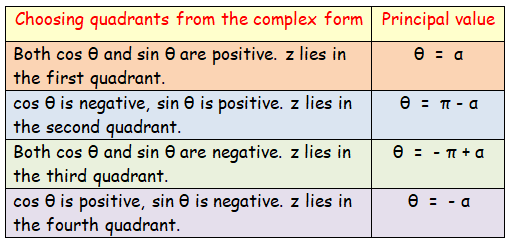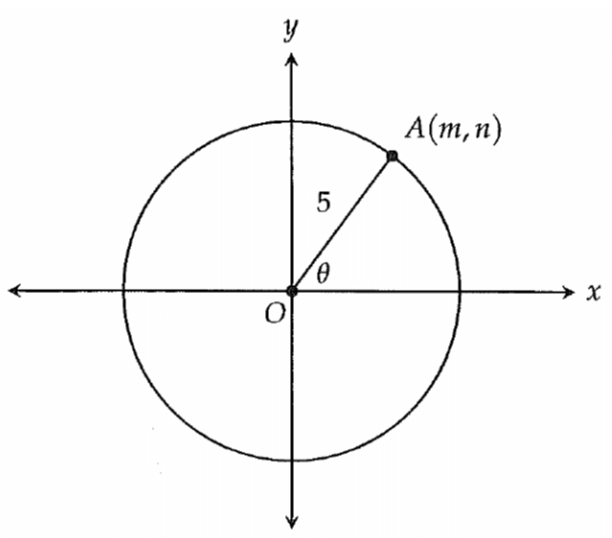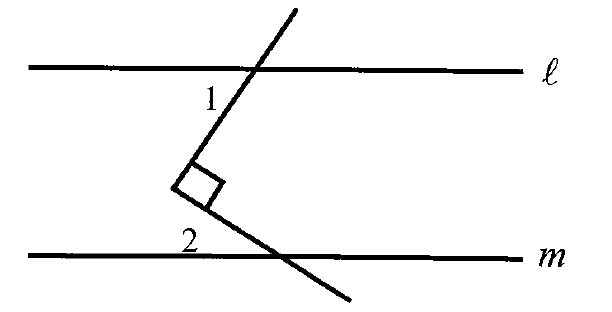POLAR FORM TO STANDARD FORM AND STANDARD FORM TO POLAR FORM EXAMPLES
What is complex number ?
A complex number is the sum of a real number and an imaginary number.
Standard form :
z = a + ib
Its represented by ‘z’.
What is polar form ?
The complex number a + bi is written in polar form as,
z = r(cos θ + i sin θ)
(where a = r cos θ, and b = r sin θ)
The value of r is called the modulus of a complex number z. i.e, r = |z|
To find the r, we use the formula r = √(a2 + b2).
The angle θ is called the argument of the complex number z. i.e, θ = arg(z).
To find the arg(z), we will use α = tan-1|b/a|.
To find the principal value θ of a complex number, we may use the following methods.

Write the complex number in standard form :
Example 1 :
3(cos 30˚ - i sin 30˚)
Solution :
Given, z = 3(cos 30˚ - i sin 30˚)
By using the calculator, we get
z = 3[√3/2 - i(1/2)]
z = 3√3/2 - 3/2i
So, the standard form is 3√3/2 - 3/2i.
Example 2 :
8(cos 210˚ + i sin 210˚)
Solution :
Given, z = 8(cos 210˚ + i sin 210˚)
By using the calculator, we get
z = 8[-√3/2 + i(-1/2)]
z = (-8√3/2) - (8/2i)
z = -4√3 - 4i
So, the standard form is -4√3 - 4i.
Example 3 :
√7(cos π/12 + i sin π/12)
Solution :
Given, z = √7(cos π/12 + i sin π/12)
By using the calculator, we get
z = √7[((√6 + √2)/4) + i((√6 - √2)/4)]
z = √7[(√6 + √2)/4] + √7[(√6 - √2)/4]i
So, the standard form is
√7[(√6 + √2)/4] + √7[(√6 - √2)/4]i
Write the complex number to polar form :
Example 4 :
2 + 2i
Solution :
Given, z = 2 + 2i
2 + 2i = r(cos θ + i sin θ) -----(1)
|
Finding the r : r = |2 + 2i| = √[(2)2 + (2)2] r = √(4 + 4) r = √8 r = 2√2 |
Finding the α : α = tan-1|b/a| α = tan-1(2/2) α = tan-1(1) α = π/4 |
Since the complex number 2 + 2i is positive, z lies in the first quadrant.
So, the principal value θ = π/4
By applying the value of r and θ in equation (1), we get
2 + 2i = 2√2(cos π/4 + i sin π/4)
So, the polar form of the complex number z is
2√2(cos π/4 + i sin π/4)
Example 5 :
-2i
Solution :
Given, z = 0 - 2i
0 - 2i = r(cos θ + i sin θ) -----(1)
|
Finding the r : r = |z| r = |0 - 2i| = √(-2)2 r = 2 |
Finding the α : α = tan-1|b/a| α = tan-1(2/0) α = tan-1(∞) α = π/2 |
Since the complex number 0 - 2i is positive and negative, z lies in the fourth quadrant.
So, the principal value θ = - π/2
By applying the value of r and θ in equation (1), we get
0 – 2i = 2(cos (-π/2) + i sin (-π/2))
So, the polar form of z is 2(cos (-π/2) + i sin (-π/2))
Example 6 :
√3 + i
Solution :
Given, z = √3 + i
√3 + i = r(cos θ + i sin θ) -----(1)
|
Finding the r : r = |√3 + i| = √[(√3)2 + (1)2] r = √4 r = 2 |
Finding the α : α = tan-1|b/a| α = tan-1(1/√3) α = π/6 |
Since the complex number √3 + i has a positive, z lies in the first quadrant.
So, the principal value θ = π/6
By applying the value of r and θ in equation (1), we get
√3 + i = 2(cos π/6 + i sin π/6)
So, the polar form of z is 2(cos π/6 + i sin π/6)

Apart from the stuff given above, if you need any other stuff in math, please use our google custom search here.
Kindly mail your feedback to v4formath@gmail.com
We always appreciate your feedback.
©All rights reserved. onlinemath4all.com
Recent Articles
-
Digital SAT Math Problems and Solutions (Part - 113)
Feb 19, 25 04:51 AM
Digital SAT Math Problems and Solutions (Part - 113) -
SAT Math Resources (Videos, Concepts, Worksheets and More)
Feb 19, 25 04:48 AM
SAT Math Resources (Videos, Concepts, Worksheets and More) -
Digital SAT Math Problems and Solutions (Part - 114)
Feb 19, 25 04:45 AM
Digital SAT Math Problems and Solutions (Part - 114)

